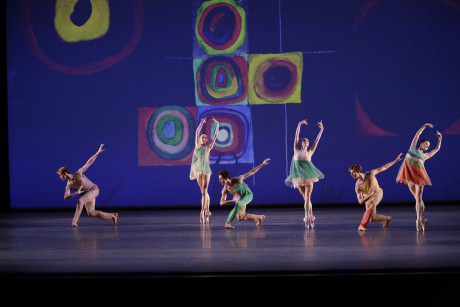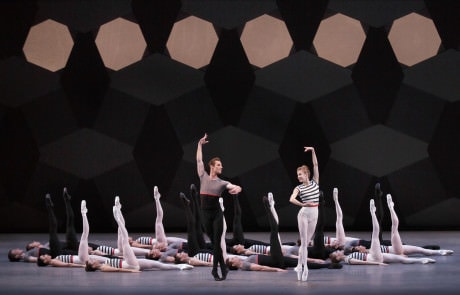Principal dancer Teresa Reichlen unwraps her leg into a développé, a blade curling a bow, then—suspends—playfully, before hiding it away. Her partner, principal Zachary Catazaro, approaches with a respectful, confident stride. Arms intertwine; pliés arc toward one another. A connection tied in an epic, melodic strain of music. Reichlen’s foot gathers in, then gives away, with each pulsing pas de cheval, then drags with linear purpose, as if tugging against a light current. A troupe of soloist men, palms flexed in plié parallel, brisés crisp and turbulent, and a percussive, proud staccato beat interrupts the love dance. Suddenly, pianissimo. Arms extend through bent wrists, beyond fingertips, even—with the legato—in time, not in response. Soloist women knot Catazaro into their string of bourrées, towing him offstage. His arm unwraps into a steady reach, as if cutting through a curtain of snow…for Reichlen, we understand. After an eerie, lilting pas de deux, eight other couples join in a near-frantic waltz step, tempo careening faster and faster, but they stay on top of the music. Later, Reichlen treks with Catazaro downstage right, from arabesque to folding knees bent, one leg tucked under her, primed to rise up again. At the very end, the two finish center stage, in a flourish, but an odyssey has taken place, a tempestuous exchange of energy.
George Balanchine said that “music, through the force of its invention, leaves strong after-images.” The previous moments from New York City Ballet Master in Chief Peter Martins’ “Symphonic Dances,” which premiered February 3, 1994, at the New York State Theater, but which were newly reflected in their program at The Kennedy Center Opera House last evening, still flash softly in my mind’s eye. Sergei Rachmaninoff’s Op. 45, conducted with delicate flair by Andrews Sill, painted a landscape in which the dancers, clad in costumes evoking Russian folk influence, could also play, toil, and find harmony.

From here, pianist Cameron Grant and choreographer Alexei Ratmansky projected their take on “Pictures at an Exhibition” (music of the same name originally written for piano by Modest Mussorgsky, and later orchestrated by famous composers like Ravel), which premiered at the David H. Koch theater last October. Principal Sara Mearns charmed in “Gnomus,” as mischievous villains tend to do, with her effortless creeping, controlled tapping of pointe shoe against floor, and consistent command of character. Sterling Hyltin and Tyler Angle summoned gravitas in the “The Old Castle,” pas de deux, navigating lush balances to faster jumps and creating a palpable, weighted urgency.
Anguished violin chords signal the start of the night’s end. Principal Tiler Peck bourrés into a royal purple light. Breaking focus as an observer almost feels blasphemous. Max Richter’s remix of the Dinah Washington song permeates into the space, water through soil. Principal Craig Hall inspires drama from his entrance. His lithe elegance balances Peck’s equally refined movement quality.
https://www.youtube.com/watch?v=4WIf2YWseg8
The third piece in the program is Christopher Wheeldon’s pas de deux “This Bitter Earth.” Wheeldon (former NYCB company member, who performed in the 1994 premiere of “Symphonic Dances”) has sculpted moving snapshots of grace. The beautiful Wendy Whelan, who made her departure from NYCB after thirty years last October, had originally danced the principal female role. If you missed a chance to see her perform, savor this iteration, for Peck holds her own. Each dip and contortion melts into the next. Peck arches back into Hall, leg bent and roving away from him, in what somewhat echoes a moment for iconic partners Suzanne Farrell and Peter Martins in Balanchine’s 1976 “Chaconne.” Peck and Hall, however, stir the spirits as tormented earthlings instead of ethereal beings.

at the Spring Gala 2014 of the New York City Ballet. Photo by Paul Kolnik.
NYCB soloist Justin Peck’s sixth ballet for the company, “Everywhere We Go,” which made its world debut last May, galvanizes as a lively and masterful close to the program. The Sufjan Stevens score proceeds at a dynamic, allegro tempo as twenty-five dancers flit from formation to formation. Peck achieves an artful mirroring result with his choreography for the corps, which often matches steps for the highlighted principal couples, so that the entire cast seems to operate as one organism, or ticking clock. The black, geometric background and black or black and white striped costumes enhance this prism effect. At one point, what felt musically and choreographically to be an upcoming climactic “lift” for the principal couple was shared between, or perhaps reflected in, multiple couples. A single culmination became a collective one. Steps were shared amidst the controlled commotion of alternating diagonal lines, links, or l-shaped formations, a reminder of the harmony embedded in this company.
In the intermission following “Pictures at an Exhibition,” I overheard a woman say to a friend of the piece’s Kandinsky backdrop: “I’ve done that puzzle!” Though the talent and technique of these dancers may be at the highest level, a message reaches out to us. There are pieces of our lives to reach back to and unwrap in this art—and watching whatever messages, whatever images, and whatever “after-images” unfold, is the gift in itself.
Running time: 2 hours 45 minutes, with two 20-minute intermissions.
The New York City Ballet’s 21st- Century Choreographers is being performed tomorrow night, Friday, April 10, 2015 and Saturday, April 11, 2015 at 7:30 p.m., and Sunday, April 12, 2015 at 1:30 p.m. in The Kennedy Center’s Opera House. For tickets, call the box office at (202) 467-4600, or order them online.
LINK
New York City Ballet: Program A: 20th Century Classics reviewed by Carolyn Kelemen on DCMetroTheaterArts.




